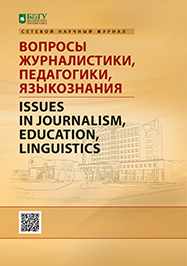Morphemic composition of the word in russian and chinese languages: comparative analysis
DOI:
https://doi.org/10.18413/2712-7451-2020-39-2-263-270Keywords:
Chinese, Russian, morpheme, morphemic parsing, morphemic analysisAbstract
A comparative analysis of Russian and Chinese languages at the morphemic level in modern
linguistics is not sufficiently represented. Although morphemes are comprehensively studied and
theoretically substantiated, there is no comparative analysis of the morpheme structure of these languages.
The presence of such an analysis can lead to better understanding the structure of the foreign language, and
therefore, contribute to the formation of lexical and grammatical competence. In this regard, the author
considers and compares units of the Russian and Chinese word. Through theoretical analysis the main
differences, similarities and relationships in the classification of morphemes are identified. The author also
explains and justifies the basic principles of morphemic analysis in the languages. The article may be of
interest to Russian and Chinese linguists in the sphere of second language acquisition. The article’s material
can be used to create exercises for solving the linguistic problem – dividing a word into components.
References
Нетяго Н.В., Дюзенли М.В. 2016. Лексикология современного русского языка: Краткий курс для иностранных учащихся. Екатеринбург, Изд-во Урал. ун-та, 100 с.
Горелов В.И. 1982. Грамматика китайского языка. М., Просвещение, 280 c.
Добренко Е.И., Соколова Е.В. 2018. К вопросу о методических основах преподавания русского языка как родного, неродного и иностранного. Лингвокультурология, 12: 78– 84.
Дюзенли М.В., Эрюй С. 2016. Явление редупликации в русском и китайском языках: к постановке проблемы. В кн.: Русский язык и лингвокультура в сопоставительном аспекте. Материалы ежегодной международной конференции кафедры русского языка для иностранных учащихся, Екатеринбург, 01-02 июня 2015 г. Под ред. У.С. Кутяевой. Екатеринбург, УрФУ им. первого Президента России Б. Н. Ельцина: 43–51.
Задоенко Т.П., Шуин Х. 1993. Основы китайского языка. Вводный курс. 2-е изд., испр. М., Наука, Восточная литература РАН, 271 с.
Ишкильдина З.К. 2017. Лингвистическая природа морфа и морфемы в русском и башкирском языках. Доклады Башкирского университета, 2 (1): 120– 123.
Кленин И.Д., Щичко В. Ф. 2013. Лексикология китайского языка. М., Восточная книга, 272 с.
Козлова М.М. 2013. Морфемный разбор слова как средство формирования языковой и коммуникативной компетенции учащихся 4–5-х классов. Филологические науки. Вопросы теории и практики, 1 (19): 104–108.
Постникова О.А. 2017. О некоторых трудностях, возникающих при изучении состава слова на занятиях по русскому языку как иностранному. Актуальные проблемы гуманитарных и социально-экономических наук, 11 (52): 62–64.
Русская грамматика. 1980. Под ред. Н. Ю. Шведовой. Т. 1. М., Наука, 789 с.
Семенас А.Л. 2005. Лексика китайского языка. М., Восток-Запад, 310 c.
Солнцев В.М. 1995. Введение в теорию изолирующих языков. М., Восточная литература РАН, 352 с.
Хаматова А.А. 2003. Словообразование современного китайского языка. М., Муравей, 222 с.
Шакун Л.М. 1975. Методы построения морфемного словаря. В кн.: Методы изучения лексики. Подред. А. Е. Супруна. Мн., Издво БГУ: 147–152.
Deng Shangqing. 2018. About the Non-Morphemeization of Modern Chinese Morpheme. Literature Education, 2 (6): 12–14 (in Chinese)
Ding Yu. 2015. Shallow Quasi-Affixes in Russian. Learning Russian, 6: 56–60 (in Chinese)
Ge Benyi. 2017. Modern Chinese Lexicology. London and New York, Routledge, 231 p.
Packard J.L. 2015. Morphology: Morphems in Chinese. The Oxford Handbook of Chinese Linguistics. Ed. William S-Y. Wang, Chaofen Sun. OxfordUniversityPress:263–273.
Yang Xuming, Zhao Ying. 2019. Review of Studies on the Determination, Classification Morpheme as Grammar Unit. Journal of Anyang College of Education, 3: 113–117 (in Chinese)
Wu Sina. 2017. The Role of Morphological Awareness in Reading Comprehension of TCSL. Chinese Teaching and Research, 1: 34–41 (in Chinese)
Abstract views: 854
Share
Published
How to Cite
Issue
Section
Copyright (c) 2020 Issues in Journalism, Education, Linguistics

This work is licensed under a Creative Commons Attribution 4.0 International License.


